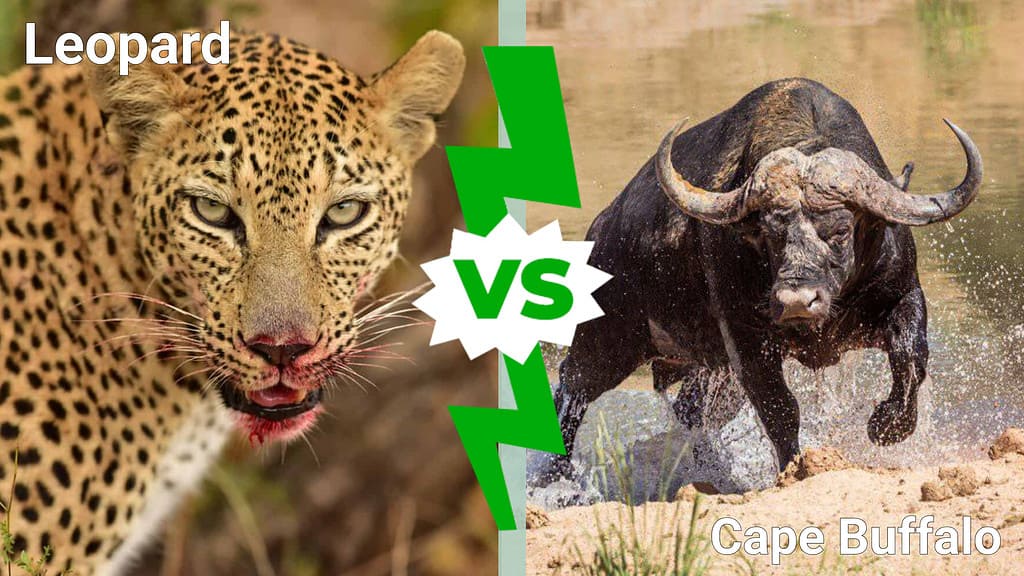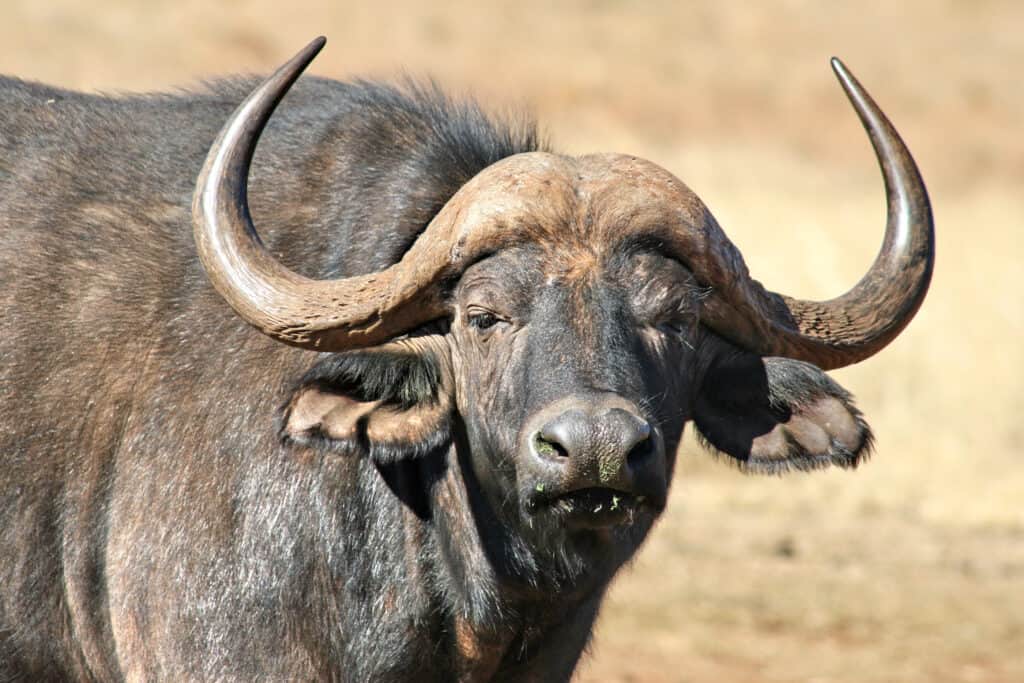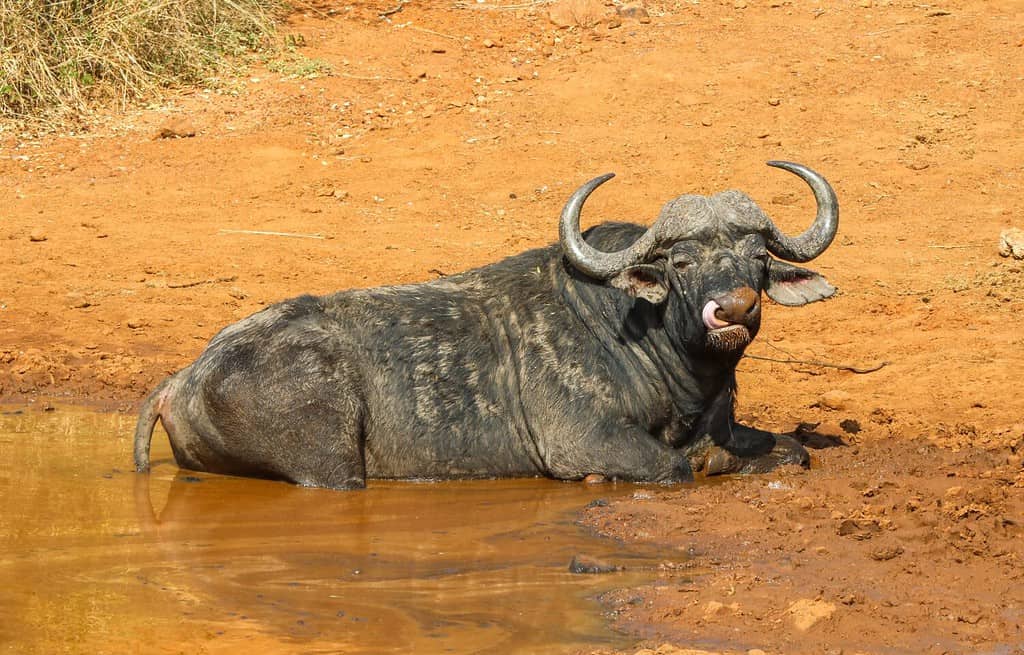Africa has a wide assortment of wildlife thriving in its various environments. Leopards are deadly predators that share a range with cape buffalo in parts of this continent, and they sometimes prey on them. Yet, there’s more to this predator-prey relationship than meets the eye. Discover how a one-on-one leopard vs. cape buffalo fight would play out with both creatures at full maturity!
Comparing a Leopard and a Cape Buffalo

| Leopard | Cape Buffalo | |
|---|---|---|
| Size | Weight: 66 to 198 pounds Height: 2 to 2.3 feet Length: 3.5 to 6.2 feet | Weight: from 600 to 2,000 pounds Length: from 6 to 8.2 feet Height: between 4 and 6 feet at the shoulder |
| Speed | – From 35 to 40 mph | – From 20 to 35 mph |
| Defenses | – Can easily climb trees to escape trouble – Has enough speed to outrun many animals – Its fur camouflages them in some environments | – Live in herds that provide protection in numbers – Their vast size makes cape buffalo unapproachable by lone hunters in many cases – Has enough speed to get away from some attackers |
| Offensive Capabilities | – Bite force of 300 to 320 psi – Has teeth 2 to 3 inches in length – Has sharp, retractable claws and powerful forelegs | – Their legs are powerful enough to deliver a fatal kick to predators in their area – Can charge and knock over predators – May gore its enemies with its sharp horns |
| Predatory Behavior | – Ambush predators that stalk prey to get close before using their speed to attack – Bites the head or neck of their prey to deliver a killing blow | – Herbivorous creature; no predatory instincts |
What Are 3 Key Differences Between a Leopard and a Cape Buffalo?

Although they’re docile herbivores, these animals can fight back against large predators.
©Hannes Thirion/Shutterstock.com
The most significant differences between a leopard and a cape buffalo are found in their size, feeding habits, and methods of attack. Cape buffalo are very large animals that can weigh up to 2,000 pounds, grow 8.2 feet long, and stand upwards of 6 feet tall, but leopards can weigh upwards of 200 pounds, stand about 2.3 feet tall, and grow up to 6.2 feet long at their utmost.
Meanwhile, leopards are stealthy hunters who attack using their teeth to kill their prey, but cape buffalo are herbivores who attack using their horns and hooves. These differences will have significant consequences for the outcome of this fight, as we’ll show below.
What Are the Key Factors in a Fight Between a Leopard and a Cape Buffalo?

The leopard is a solitary and nocturnal animal that hunts both on the ground and in the trees.
©Rudi Hulshof/Shutterstock.com
As with most other fights in the animal kingdom, the battle between a leopard and a cape buffalo will come down to the elements of size, speed, defenses, offensive skills, and how the animal preys on others. To figure out if a leopard can beat a cape buffalo in a one-on-one bout, we must examine each of these qualities. The next section will show a comparison of these mammals in five different areas. After we figure out which creature has the advantage in each situation, we’ll use that information to inform the final section where we determine the battle’s winner.
Leopard vs. Cape Buffalo: Size
Cape buffalo are larger than leopards. Leopards only weigh about 200 pounds at their maximum, and they weigh anywhere from 66 to 200 pounds as adults. They only stand about 2.3 feet tall and grow from 3.5 to 6.2 feet long. They’re not the largest of the so-called “big cats.”
Meanwhile, cape buffalo are very large. They’re capable of weighing from 600 pounds to 2,000 pounds. Also, they stand from 4 to 6.3 feet tall, towering over the leopard.
The cape buffalo has the size advantage in this case.
Leopard vs. Cape Buffalo: Speed
Leopards use bursts of speed to help them attack their prey after stalking them for some time. These felines are quick, capable of reaching between 35 and 40 miles per hour. Despite their size, cape buffalo are not slow by any means. Instead, they can reach speeds of 20 to 35 miles per hour or slightly more while running.
Leopards have a slight edge in terms of speed.
Leopard vs. Cape Buffalo: Defenses
Cape buffalo have some pretty good defenses that make them hard for a lone predator to kill. First off, they’re very large, so attacking them is a risky endeavor that requires precise timing and effort to avoid being trampled or gored. Also, they tend to live in large herds, so predators have to wait for old, slow, injured, unlucky, or young cape buffalo to hunt. In this case, the cape buffalo is all alone, though.
Leopards have the benefit of their stealthy nature, including their fur’s camouflage which can make them very tough to see. Leopards can stalk their prey over long distances or wait in place to ambush them. These animals are also great at climbing trees, making it hard for other animals to pursue them or steal their kills.
Cape buffalo have a defensive advantage.
Leopard vs. Cape Buffalo: Offensive Capabilities
Cape buffalo use their powerful legs, weight, and horns to attack other animals. Their horns may not be very long, but they’re more than enough to cause a severe or fatal goring injury to predators, including lions. Cape buffalo can also trample and kick predators, and their legs are strong enough to cause serious injuries or outright kill large animals.
Leopards, like other big cats, kill prey using a deadly bite. These animals can exert a bite force of 300 to 320 psi. Their largest teeth measure between 2 and 3 inches in length, allowing them to deal a deadly bite to their prey’s head or neck. They also have sharp, retractable claws that they use to grasp prey and climb trees.
The cape buffalo has more power behind it compared to the precision required for a leopard to kill its prey, so it has the advantage in this case.
Leopard vs. Cape Buffalo: Predatory Behavior
Cape buffalo lack predatory behavior since they are herbivores. Leopards are ambush predators. They can lie in wait for their prey or actively stalk it. Once they get in range, they’ll chase their prey using a burst of speed and try to bite it on the head or neck, a quick and fatal attack. After they kill their prey, they’ll often drag it up into a tree where they can eat in peace.
Leopards have the advantage in predatory behavior.
Who Would Win in a Fight Between a Leopard and a Cape Buffalo?

A leopard would probably not think to attack a cape buffalo, but it would lose the fight if it did.
©Photography Phor Phun/Shutterstock.com
A cape buffalo would win a fight against a leopard. Leopards prey on cape buffalo, but only on juveniles or otherwise incapacitated adults. Cape buffalo are simply too large and strong for a leopard to attack on their own. Leopards are solitary cats, so they don’t have a group of other members of their species with which they could try to take large prey.
If a leopard did attempt to attack a cape buffalo, it may not be able to exert enough force on the larger animal’s body to cause fatal injuries. Even if it could, the buffalo would probably kick or gore the leopard to death long before it sustained fatal damage. With that in mind, the cape buffalo comes away the winner of this fight.
The photo featured at the top of this post is © JamesCookPhotography/Shutterstock.com
Thank you for reading! Have some feedback for us? Contact the AZ Animals editorial team.







